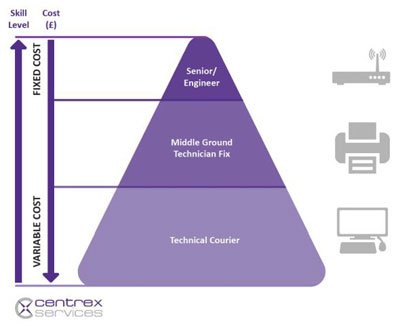The battlefield of the technology support industry: ‘no man’s land’ takes centre stage
“The secret of great battles consists in knowing how to deploy and concentrate at the right time.” – Napoleon Bonaparte
Some of the most significant changes that technology has delivered over the past few years have changed the approach to most markets, but for the break-fix market, it has come to a point in its evolution that has placed it on the brink of turmoil. At the heart of the technology support industry, field engineering and the associated service supply chain is emerging as the new battlefield.
The advancement of the industry is emerging as an issue now because technology products have been simplified, the need for traditional, high-end engineering skills required in the field is diminishing – almost to the point of extinction. The result is that continued market pressures are pushing the legacy fragmented technology support – the service supply chains – into a non-competitive position.
This has come to a head as customers no longer require high-end expertise to repair retail, hospitality or print technology; the priority is to replace the unit in the shortest time possible, ensuring an immediate return to productivity at the lowest possible cost.
When compared to wider innovative technology development, the break fix market remains fragmented and stagnant, having progressed over the years into silos which have operated in ivory towers. Evidence of this is seen in major contracts where the supply chain for a single IT hardware call involved one service provider sub-contracting to three different repairers, three individual logistics loops, two technical couriers and three parts providers. These businesses are refusing to modernise the outdated service supply chain model currently plaguing the industry.
Where’s the battle?
This reluctance to change the way businesses operate and think is harming the technology support industry, and Glyn Dodd, managing director of technology support specialist Centrex Services, believes the worst is yet to come.
“Hardware technology is always evolving yet the support business is stuck using an antiquated supply chain which hasn’t offered true value or innovation to the customer for years,” he says.
Dodd sees a distinctive, yet variable change in the approach and structure to the service supply chain. The level of skilled expertise required to service complex technology is still necessary, while the traditional ‘swap’ services can continue to be handled by a technical courier. Between these two skill sets is where he sees the battle – the middle ground.

The middle ground’s effect on service
So what is shaping this battle and what are the components that have put this service provision into a state of flux?
Dodd explains, “The first major component of the battle lies in the price structure of hardware maintenance support. We’ve seen hardware technology commoditise, which has changed the perceived value of product hardware and the way that it is serviced. This has increased the price pressure within the middle ground.
The second component (and possibly a result of the price pressure) is the accelerated silos of multiple suppliers throughout the supply chain, increasing the number of ivory towers and the chasms that exist between them. The number of suppliers and subcontractors involved in a single IT hardware support has culminated in fragmented, confused and complex supply chains.
The third and probably one of the most key constituents of the middle ground is the price of engineers, as service suppliers can no longer afford skilled field service engineers to respond to low level incidents.”
Reskilling engineers is vital
With technical couriers and middle ground technicians dealing with the majority of incidents, the role of field service engineers has to change in line with the service supply chain. The skilled engineers remain vital; focused at the top of the skill pyramid, providing services within the data centre and other complex technology areas such as multi-functional devices and networks. However, they will need to be deployed in a different way to provide the most cost-effective model possible and employed in far less quantities than they are today.
Dodd says, “The level of expertise skilled engineers have should never be overlooked. When technology stops working, businesses stop working and it is often this vital part of the service which enables companies to get back up and running again, within the service level agreement. We simply need to readdress the economics of demand, aligning skill to activity to service revenue model.
As the nature of field service is changing, it’s rendering the current field service model outdated and expensive. Using technical couriers is the favoured method of replacement rather than a traditional engineer; however, using the full potential of field service engineers within the emerging middle ground activity is now becoming a waste of skilled resources and fails to offer true value to the customer.”
As highlighted, end-user pricing associated with field services is decreasing, but price-pressure in the legacy model, including the deployment of engineers isn’t. The average engineer’s salary is currently reaching £34,000, substantially higher than the emerging middle ground technician who earns £20/25,000. The industry simply can’t afford to support field service engineers working at this level, despite their vast expertise. As price-pressure rates continue to fall, this issue is only going to get worse.

Modernising technical support
As well as rejuvenating the service, remodelling the cost and ensuring the workforce is effectively deployed, the service supply chain must be connected in an intelligent way – centralised around astute contact centre services. Each process can be challenged and streamlined, culminating in a chain that is valuable, capable, available, adequate and flexible.
Dodd believes modernisation is vital to the future stability of after sales support. “It’s clear that the current technology support model is not fit for purpose and is actively harming the industry. We all talk and think about putting the customer first, but taking a holistic view of this industry, it seems no one is designing these services with customer satisfaction in mind.
The delivery infrastructure needs a complete overhaul, moving away from the fragmented supply chain currently plaguing technology support towards a more streamlined, connected approach. Redesigning the interaction between each element of the supply chain, from control centre to repair, will breed high-quality service.
“We must redesign the battlefield as by changing the thinking, creating greater intelligence and deploying with full traceability, the middle ground break-fix will cease to be the daily battle-zone. Instead, technology support will profit from a lean, customer first service supply chain, once again adding true value for the customer.”
About Centrex Services
Centrex Services provides all elements of technology hardware support, from initial contact centre triage, placing the correctly skilled engineer on site with the right part – within the Service Level Agreement (SLA).
We work with a range of companies from small independent businesses, in all types of industries, to channel partners, buying groups and large retail chains.

Find out more about our service solutions. Enquiry Form.








































